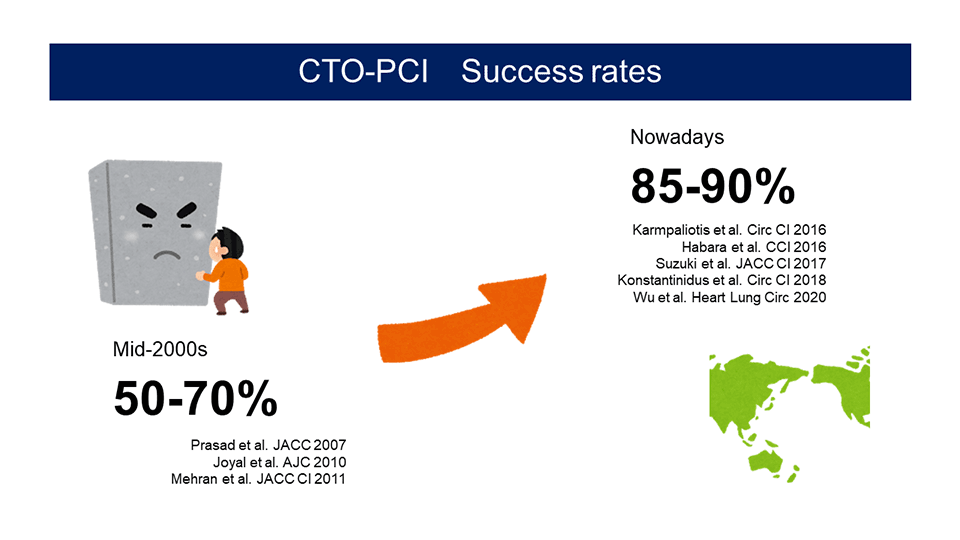News | COMPLEX PCI 2023
When to Go Retrograde?
Insight from a pooled Analysis of CTO PCI

Maoto Habara
Toyohashi Heart Center, Japan
The groundbreaking work of Dr. Maoto Habara from Toyohashi Heart Center in Japan took center stage as he shared insights on the optimal timing and considerations for a retrograde approach in Chronic Total Occlusion (CTO) Percutaneous Coronary Intervention (PCI).
In the dynamic realm of CTO PCI, the pivotal question of when to adopt a retrograde approach has become a focal point. Over the years, the success rate of CTO PCI has experienced a remarkable surge from 50-70% to a robust 85-90%, underscoring the evolution of techniques and technologies within this specialized field.

Key contributors to this significant improvement include the refinement of equipment. Innovative techniques, such as parallel wire approaches, IVUS-guided rewiring, ADR, and retrograde methodologies, have become instrumental in achieving higher success rates. A thorough understanding of CTO pathology and the nuanced mechanics of guidewire manipulation, involving factors like deflection, and whipping motion, has proven pivotal in this advancement.
Recent registry data, incorporating insights from Asian CTO experts along with data from Europe and the US, consistently show procedural success rates exceeding 85%. The retrograde approach, employed in approximately 20-30% of cases, emerges as a critical component in contemporary CTO PCI practices. Its efficacy becomes particularly evident in complex CTO scenarios where the antegrade approach encounters challenges and in cases with compromised distal vessel quality or notable side branches at the distal cap. Notably, the retrograde approach minimizes contrast consumption in patients with chronic kidney disease, adding another layer to its benefits.
Critical considerations in this decision-making process encompass dual injection, thorough angiogram analysis, and confirmatory IVUS checks in the presence of ambiguity at the proximal cap or poor distal vessel quality. The angle of the retrograde channel, vessel size, and other factors play a crucial role in the assessment, guiding the decision-making process. Real-world cases vividly illustrate the retrograde approach's efficacy in scenarios like proximal cap ambiguity, distal exit uncertainty, and antegrade penetration challenges.
Guideline recommendations advocate restricting antegrade guidewire manipulation to a 20-minute window due to associated risks, underscoring the importance of a thoughtful and timely approach.
In conclusion, the decision of when to opt for the retrograde approach hinges on variables such as proximal cap ambiguity, distal vessel quality, and the success of antegrade wiring within a 20-minute timeframe. This nuanced decision-making process, coupled with alternatives like ADR, parallel wire, or IVUS-guided rewiring, serves as a cornerstone for optimizing success in CTO PCI procedures.
Edited by

Jinho Lee, MD
Kyung Hee University Hospital, Korea (Republic of)

KyungAe Kim, RN
CardioVascular Research Foundation (CVRF), Korea (Republic of)

Maoto Habara
Toyohashi Heart Center, Japan
The groundbreaking work of Dr. Maoto Habara from Toyohashi Heart Center in Japan took center stage as he shared insights on the optimal timing and considerations for a retrograde approach in Chronic Total Occlusion (CTO) Percutaneous Coronary Intervention (PCI).
In the dynamic realm of CTO PCI, the pivotal question of when to adopt a retrograde approach has become a focal point. Over the years, the success rate of CTO PCI has experienced a remarkable surge from 50-70% to a robust 85-90%, underscoring the evolution of techniques and technologies within this specialized field.

Key contributors to this significant improvement include the refinement of equipment. Innovative techniques, such as parallel wire approaches, IVUS-guided rewiring, ADR, and retrograde methodologies, have become instrumental in achieving higher success rates. A thorough understanding of CTO pathology and the nuanced mechanics of guidewire manipulation, involving factors like deflection, and whipping motion, has proven pivotal in this advancement.
Recent registry data, incorporating insights from Asian CTO experts along with data from Europe and the US, consistently show procedural success rates exceeding 85%. The retrograde approach, employed in approximately 20-30% of cases, emerges as a critical component in contemporary CTO PCI practices. Its efficacy becomes particularly evident in complex CTO scenarios where the antegrade approach encounters challenges and in cases with compromised distal vessel quality or notable side branches at the distal cap. Notably, the retrograde approach minimizes contrast consumption in patients with chronic kidney disease, adding another layer to its benefits.
Critical considerations in this decision-making process encompass dual injection, thorough angiogram analysis, and confirmatory IVUS checks in the presence of ambiguity at the proximal cap or poor distal vessel quality. The angle of the retrograde channel, vessel size, and other factors play a crucial role in the assessment, guiding the decision-making process. Real-world cases vividly illustrate the retrograde approach's efficacy in scenarios like proximal cap ambiguity, distal exit uncertainty, and antegrade penetration challenges.
Guideline recommendations advocate restricting antegrade guidewire manipulation to a 20-minute window due to associated risks, underscoring the importance of a thoughtful and timely approach.
In conclusion, the decision of when to opt for the retrograde approach hinges on variables such as proximal cap ambiguity, distal vessel quality, and the success of antegrade wiring within a 20-minute timeframe. This nuanced decision-making process, coupled with alternatives like ADR, parallel wire, or IVUS-guided rewiring, serves as a cornerstone for optimizing success in CTO PCI procedures.
Edited by

Jinho Lee, MD
Kyung Hee University Hospital, Korea (Republic of)

KyungAe Kim, RN
CardioVascular Research Foundation (CVRF), Korea (Republic of)

Leave a comment